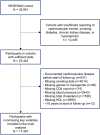Viremia Does Not Independently Predict Cardiovascular Disease in People With HIV: A RESPOND Cohort Study
- PMID: 39896984
- PMCID: PMC11786055
- DOI: 10.1093/ofid/ofaf016
Viremia Does Not Independently Predict Cardiovascular Disease in People With HIV: A RESPOND Cohort Study
Abstract
Background: HIV viremia has been considered a cardiovascular disease (CVD) risk factor, but many studies have had insufficient data on potential confounders. We explored the association between viremia and CVD after adjusting for established risk factors and analyzed whether consideration of viremia would improve CVD prediction.
Methods: Adults from RESPOND were followed from the first date with available data until the first of rigorously defined CVD, loss to follow-up, death, or administrative censoring. We first analyzed the associations between 6 measures of viremia (time-updated, before antiretroviral therapy [ART], viremia category, and measures of cumulative viremia) and CVD after adjusting for the variables in the D:A:D CVD score (age, sex/gender, smoking, family history, diabetes, recent abacavir, CD4 count, blood pressure, cholesterol, high-density lipoprotein, cumulative use of stavudine, didanosine, indinavir, lopinavir, and darunavir). We subsequently compared predictive performance with and without viremia in 5-fold internal cross-validation.
Results: A total of 547 events were observed in 17 497 persons (median follow-up, 6.8 years). Although some viremia variables were associated with CVD in univariable analyses, there were no statistically significant associations after adjusting for potential confounders, neither for measures of current viral load, pre-ART viral load, highest viremia category during ART, nor cumulative viremia (modeled both as total cumulative viremia, cumulative viremia during ART, and recent cumulative viremia). Consistently, none of the viremia variables improved prediction capacity.
Conclusions: In this large international cohort, HIV viremia was not associated with CVD when adjusting for established risk factors. Our results did not show viremia to be predictive of CVD among people with HIV.
Keywords: HIV viremia; cardiovascular diseases; myocardial infarction; prediction; stroke.
© The Author(s) 2025. Published by Oxford University Press on behalf of Infectious Diseases Society of America.
Conflict of interest statement
Potential conflicts of interest. O.E. reports speaker fee from Gilead Sciences, unrelated to this work. H.F.G. reports honoraria for data and safety monitoring board or advisory board membership from Merck, Gilead Sciences, ViiV Healthcare, GSK, Janssen, Johnson & Johnson, and Novartis; a travel grant from Gilead Sciences; unrestricted research grants from Gilead Sciences and ViiV; grants or contracts paid to institution from the Swiss National Science Foundation, Swiss HIV Cohort Study, National Institute of Health; and an unrestricted research grant from Gilead Sciences, Bill and Melinda Gates Foundation and Yvonne Jacob Foundation. F.W. reports consultancy work for ViiV healthcare for which his institution received payment. H.K. reports speaker fees from Gilead Sciences and ViiV, unrelated to this work. S.H. reports advisory board membership from ViiV Healthcare. O.K. reports honoraria for presentations at meetings supported by Merck, unconditional research grants from Gilead and travel support from Gilead and ViiV. H.G., J.R., and L.Y. are employees of ViiV Healthcare, Gilead Sciences, and MSD, respectively. The remaining authors report no conflicts of interest.
Figures


References
-
- Jaschinski NJ, Greenberg L, Neesgaard B, et al. Temporal Trends of Cardiovascular Disease Incidence in People with HIV from 2001-2021. Poster presented at: Conference on Retroviruses and Opportunistic Infections (CROI) 2024; 2024 March 3–6; Denver, Colorado, USA.
-
- EACS Guidelines version 12.0, October 2023. Available at Available at: https://www.eacsociety.org/guidelines/eacs-guidelines/ [Accessed October 26, 2023].
LinkOut - more resources
Full Text Sources
Research Materials

